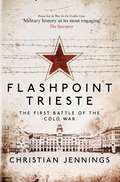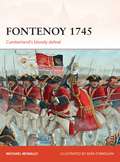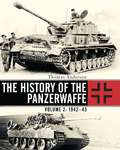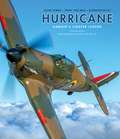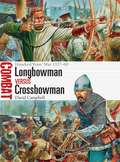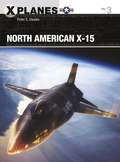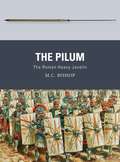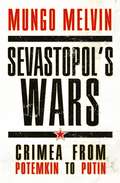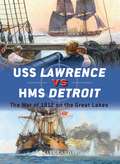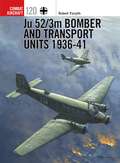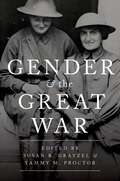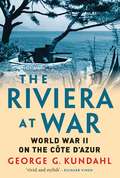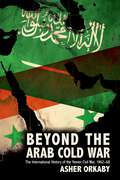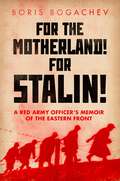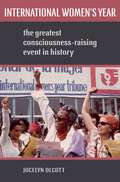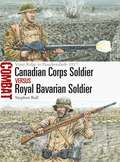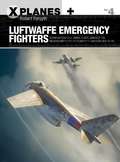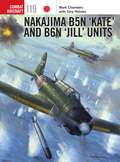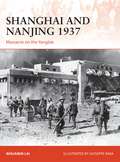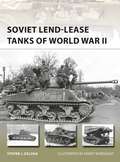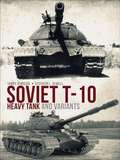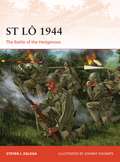- Table View
- List View
Flashpoint Trieste: The First Battle of the Cold War
by Christian JenningsFlashpoint Trieste is the story of one year in one city as the Cold War begins. The Western Allies captured the Adriatic port city before the Russians could reach it, but having survived the war, everybody is now desperate to make it through the liberation. Life is fast and violent, as former warring parties find common cause against the Soviet Union and the borders of the new Europe are being hammered out. Against this deadly backdrop of espionage, escape and revenge, the British and Americans are locked into the opening stages of the Cold War on the beautiful shores of the Adriatic, opposing the Russians and Yugoslavs. Now published in paperback, this is the story of the first turbulent post-war year of lethal cat-and-mouse in south-eastern Europe, told through the stories of twelve men and women from seven different countries thrown together on a strategically vital frontier between East and West.
Fontenoy 1745: Cumberland's bloody defeat (Campaign #307)
by Michael McNally Seán Ó’BrógáinA disputed succession to the Austrian throne led to general war between the leading powers of Europe in 1740, with France, Spain and Prussia on one side, and Britain, Habsburg Austria and the Dutch Republic on the other. While fighting occurred across the globe, the bloodiest battles were fought on the European continent, with none more costly than the battle of Fontenoy in 1745.Fearing an encirclement of France by a resurgent Habsburg-controlled Austria, the French commander Marshall Saxe planned to overrun the Austrian Netherlands, thereby dealing a decisive blow against their enemy's ability to wage war. Saxe's army, the cream of the French military, invaded and set up a defensive position at Fontenoy, near Tournai – daring his enemies to knock him off his perch. This title, beautifully illustrated with full colour plates, is an in-depth study of the British Duke of Cumberland's attempt to assault Saxe's position. It focuses on the inability of allied leaders to coordinate their attacks and how Cumberland came within a whisker of achieving a major victory.
The History of the Panzerwaffe: Volume 2: 1942–45
by Thomas AndersonThe final years of World War II saw the legendary Panzerwaffe face its most difficult challenges, with Allied troops landing at Normandy and storming across the continent and the Russians gaining the upper hand on the Eastern Front. As Germany fought fiercely to hold on to the advantages gained in the early years, they relied heavily on the Panzer IV, the Panzer V Panther and the StuG III – the backbone of their infamous armoured divisions – to hold back their advancing opponents. This second volume on the Panzerwaffe offers a comprehensive guide to the final years of Germany's most famous fighting force, covering the further use of the Panzer IV, the role played by the StuG III assault gun and the battlefield debut of the formidable Panther. Explosive combat reports and rare archive photographs help uncover the final years of the Panzers, from their defence against the D-Day landings and the role they played in the Ardennes Offensive to their valiant last stand in Berlin.
Hurricane: Hawker's Fighter Legend
by John Dibbs Tony Holmes Gordon Riley2017 marks the 80th anniversary of the remarkable Hawker Hurricane formally entering service. The RAF's first monoplane fighter, it dragged the Air Force into a position where it could defend Britain in her 'hour of need'. The true workhorse of the RAF, the Hurricane came into its own in the hot summer months of 1940 valiantly defending the skies above Britain. Outnumbering Spitfires three to one, the Hurricane also downed far more enemy aircraft. Without the obvious elegance of the Me 109 or the Spitfire, the Hurricane was nonetheless beloved by its pilots for its ability to simultaneously take a battering and inflict serious damage from its remarkably stable gun platform. This stunning new book reveals the Hurricane in all its glory – from fascinating first-hand accounts from the men who flew her to the truly breathtaking images from John Dibbs of the Hurricanes still in flight today. This lavish, fully illustrated edition is a must-have for all fans of aviation history.
Longbowman vs Crossbowman: Hundred Years’ War 1337–60 (Combat)
by Peter Dennis David CampbellFor centuries, the crossbow had played a key role on the battlefields of continental Europe, with mercenaries from Genoa and Brabant in particular filling the ranks of the French army, yet on the outbreak of the Hundred Years' War they came up against a more powerful foe. To master the English longbow was a labour of years, requiring far greater skill to use than the crossbow, but it was much more flexible and formidable, striking fear into the French and their allies.This study examines three battles – Sluys (1340), Crécy (1346) and Poitiers (1356) – and shows how the use of the longbow allowed England's armies to inflict crushing defeats on numerically superior forces. The longbow changed the shape of war, becoming the defining weapon of the age and wreaking havoc upon the French armies that would face it. Featuring full-colour artwork, this is the engrossing story of the first clashes between the English longbowmen and the crossbowmen of the French king on the bloody battlefields of the Hundred Years' War.
North American X-15 (X-Planes)
by Peter E. DaviesThe revolutionary X-15 remains the fastest manned aircraft ever to fly. Built in the two decades following World War II, it was the most successful of the high-speed X-planes. The only recently broken 'sound barrier' was smashed completely by the X-15, which could hit Mach 6.7 and soar to altitudes above 350,000ft, beyond the edge of space. Several pilots qualified as astronauts by flying above 50 miles altitude in the X-15, including Neil Armstrong, the first man on the Moon. The three X-15s made 199 flights, testing new technologies and techniques which greatly eased America's entry into manned space travel, and made the Apollo missions and Space Shuttle viable propositions. With historical photographs and stunning digital artwork, this is the story of arguably the greatest of the X-Planes.
The Pilum: The Roman Heavy Javelin (Weapon)
by Peter Dennis M. C. BishopA heavy javelin, normally used as a shock weapon immediately before contact, the pilum was designed with a particular speciality: it could penetrate a shield and carry on into the individual behind it. Relying on mass rather than velocity, at short range a volley of pila had much the same effect on a charging enemy as musketry would in later periods. The design was not uniform, with a wide diversity of types throughout the developmental history of the weapon, but for more than four centuries it remained a vital part of the arsenal of weapons at the disposal of the Roman legionary. Drawing upon recent major finds in the Iberian Peninsula and the Balkans, as well as written records and rigorous scientific analysis, this enthralling study lifts the veil on the evolving nature of the pilum, the Roman heavy javelin that helped to conquer the known world.
Sevastopol’s Wars: Crimea from Potemkin to Putin
by Mungo Melvin CB OBEFounded by Catherine the Great, the maritime city of Sevastopol has been fought over for centuries. Crucial battles of the Crimean War were fought on the hills surrounding the city, and the memory of this stalwart defence inspired those who fruitlessly battled the Germans during World War II. Twice the city has faced complete obliteration yet twice it has risen, phoenix-like, from the ashes.In this groundbreaking volume, award-winning author Mungo Melvin explores how Sevastopol became the crucible of conflict over three major engagements – the Crimean War, the Russian Civil War and World War II – witnessing the death and destruction of countless armies yet creating the indomitable 'spirit of Sevastopol'. By weaving together first-hand interviews, detailed operational reports and battle analysis, Melvin creates a rich tapestry of history.
USS Lawrence vs HMS Detroit: The War of 1812 on the Great Lakes (Duel)
by Paul Wright Mark LardasThe most critical naval fighting during the War of 1812 took place, not on the high seas, but on the inland lakes of North America: the Great Lakes and Lake Champlain. Carrying between 12 and 22 cannon, the British and American sloops-of-war were ship-rigged, brig-rigged or schooner-rigged vessels. Lakes actions often involved two ships facing each other broadside to broadside, the best example of which was the battle of Lake Erie in 1813 where HMS Detroit led a Royal Navy squadron against the USS Lawrence-led US Navy.Featuring full-colour artwork, this lively study investigates the prolonged struggle between British and US sloops-of-war, highlighting the differences between the war on the lakes and the war on the oceans during the Age of Fighting Sail. It reveals the circumstances under which these ships were built, how they were armed, and the human story behind their construction and use in battle.
Ju 52/3m Bomber and Transport Units 1936-41 (Combat Aircraft)
by Jim Laurier Robert Forsyth Mark PostlethwaiteThe all-metal Junkers Ju 52/3m enjoyed a solid – indeed, revered – reputation amongst its crews and the troops and paratroopers who used and depended on it. For more than ten years, it saw service as a successful military transport, with its distinctive, three-engined design and corrugated metal construction becoming instantly recognisable. It was a mainstay in the Luftwaffe's inventory, first seeing service in the 1930s in bombing and transport operations in the Spanish Civil War, and subsequently during the German invasion of Poland. It then served on every front on which the Luftwaffe was deployed until May 1945. The Junkers served as a stalwart transport, confronting both freezing temperatures and ice, and heat and dust, lifting men, animals, food and supplies vital for German military operations. This, the first of two books on the Ju 52/3m, details its service as a bomber in Spain and in South America, followed by its pivotal role in early war operations during the invasions of Poland and France, the airborne invasion of Crete and the early stages of Operation Barbarossa.
Gender and the Great War
by Susan R. Grayzel Tammy M. ProctorThe centenary of the First World War in 2014-18 offers an opportunity to reflect upon the role of gender history in shaping our understanding of this pivotal international event. From the moment of its outbreak, the gendered experiences of the war have been seen by contemporary observers and postwar commentators and scholars as being especially significant for shaping how the war can and must be understood. The negotiating of ideas about gender by women and men across vast reaches of the globe characterizes this modern, instrumental conflict. Over the past twenty-five years, as the scholarship on gender and this war has grown, there has never been a forum such as the one presented here that placed so many of the varying threads of this complex historiography into conversation with one another in a manner that is at once accessible and provocative. Given the vast literature on the war itself, scholarship on gender and various themes and topics provides students as well as scholars with a chance to think not only about the subject of the war but also the methodological implications of how historians have approached it. While many studies have addressed the national or transnational narrative of women in the war, none address both femininity and masculinity, and the experiences of both women and men across the same geographic scope as the studies presented in this volume.
Riviera at War: World War II on the Côte d'Azur
by George G. KundahlDuring World War II three distinct forces opposed the Allies - Germany, Italy, and Japan. Few areas of the world experienced domination by more than a single one of these, but southeastern France - the region popularly known as the Riviera or Cote d'Azur - was one. Not only did inhabitants suffer through Italian Fascism and German Nazism but also under a third hardship at times even more oppressive - the rule of Vichy France. Following a nine-month prelude, the reality of World War II burst onto the Riviera in June 1940 when the region had to defend itself against the Italian army and ended in April 1945 with a battle against German and Italian forces in April 1945, a period longer than any other part of France. In this book, George G. Kundahl tells for the first time the full story of World War II on the French Riviera. Featuring previously unseen sources and photographs, this will be essential reading for anyone interested in wartime France.
Beyond the Arab Cold War: The International History of the Yemen Civil War, 1962-68 (Oxford Studies in International History)
by Asher OrkabyBeyond the Arab Cold War brings the Yemen Civil War, 1962-68, to the forefront of modern Middle East History. During the 1960s, in the wake of a coup against Imam Muhammad al-Badr and the formation of the Yemen Arab Republic (YAR), Yemen was transformed into an arena of global conflict. Believing al-Badr to be dead, Egypt, the Soviet Union, and most countries recognized the YAR. But when al-Badr unexpectedly turned up alive, Saudi Arabia and Britain offered support to the deposed Imam, drawing Yemen into an internationally-sponsored civil war. Throughout six years of major conflict, Yemen sat at the crossroads of regional and international conflict as dozens of countries, international organizations, and individuals intervened in the local South Arabian civil war. Yemen was a showcase for a new era of UN and Red Cross peacekeeping, clandestine activity, Egyptian counterinsurgency, and one of the first largescale uses of poison gas since WWI. Events in Yemen were not dominated by a single power, nor were they sole products of US-Soviet or Saudi-Egyptian Arab Cold War rivalry. Britain, Canada, Israel, the UN, the US, and the USSR joined Egypt and Saudi Arabia in assuming varying roles in fighting, mediating, and supplying the belligerent forces. Despite Cold War tensions, Americans and Soviets appeared on the same side of the Yemeni conflict and acted mutually to confine Egyptian President Gamal Abdel Nasser to the borders of South Arabia. The end of the Yemen Civil War marked the end of both Nasser's Arab Nationalist colonial expansion and the British Empire in the Middle East, two of the most dominant regional forces. This internationalized conflict was a pivotal event in Middle East history, overseeing the formation of a modern Yemeni state, the fall of Egyptian and British regional influence, another Arab-Israeli war, Saudi dominance of the Arabian Peninsula, and shifting power alliances in the Middle East that continue to lie at the core of modern-day conflicts in South Arabia.
For The Motherland! For Stalin!: A Red Army Officer's Memoir of the Eastern Front
by Boris BogachevBoris Bogachev's highly readable account of life as a young platoon commander during the Great Patriotic War of 1941-45 makes for a fascinating read. The son of a Soviet military commissar, Bogachev volunteered to fight as soon as reached the age of seventeen. Life in the Red Army was harsh, with food shortages, inadequate equipment and fear - not only of the well-armed enemy ahead, but also of the trigger-happy political officers behind. Bogachev fought in many campaigns throughout the war, including the 15-month Rzhev salien "meat-grinder" which resulted in huge Soviet losses. On three occasions he was threatened with execution. Three times he was wounded. Determined and resourceful, he managed to obtain papers authorizing him to have his wounds treated in hospital, but instead smuggled himself aboard a train to travel across Russia to visit his family in Kazakhstan before returning to the front. Boris Bogachev, who retired from the Soviet army in 1984 as a much-decorated colonel, tells his story of the hell that was the Eastern Front with freshness and candor. He vividly conveys the wide gap between ideology and reality in Stalin's Russia, the warm camaraderie among those who fought the Nazis and his horror at the inhumanity of war.
International Women's Year: The Greatest Consciousness-Raising Event in History
by Jocelyn OlcottAmid the geopolitical and social turmoil of the 1970s, the United Nations declared 1975 as International Women's Year. The capstone event, a two-week conference in Mexico City, was dubbed by organizers and journalists as "the greatest consciousness-raising event in history." The event drew an all-star cast of characters, including Soviet cosmonaut Valentina Tereshkova, Iranian Princess Ashraf Pahlavi, and US feminist Betty Friedan, as well as a motley array of policymakers, activists, and journalists. International Women's Year, the first book to examine this critical moment in feminist history, starts by exploring how organizers juggled geopolitical rivalries and material constraints amid global political and economic instability. The story then dives into the action in Mexico City, including conflicts over issues ranging from abortion to Zionism. The United Nations provided indispensable infrastructure and support for this encounter, even as it came under fire for its own discriminatory practices. While participants expressed dismay at levels of discord and conflict, Jocelyn Olcott explores how these combative, unanticipated encounters generated the most enduring legacies, including women's networks across the global south, greater attention to the intersectionalities of marginalization, and the arrival of women's micro-credit on the development scene. This watershed moment in transnational feminism, colorfully narrated in International Women's Year, launched a new generation of activist networks that spanned continents, ideologies, and generations.
Anarchism, 1914–18: Internationalism, anti-militarism and war
by Matthew Adams Ruth KinnaAnarchism 1914–18 is the first systematic analysis of anarchist responses to the First World War. It examines the interventionist debate between Peter Kropotkin and Errico Malatesta which split the anarchist movement in 1914 and provides a historical and conceptual analysis of debates conducted in European and American movements about class, nationalism, internationalism, militarism, pacifism and cultural resistance. Contributions discuss the justness of war, non-violence and pacifism, anti-colonialism, pro-feminist perspectives on war and the potency of myths about the war and revolution for the reframing of radical politics in the 1920s and beyond. Divisions about the war and the experience of being caught on the wrong side of the Bolshevik Revolution encouraged anarchists to reaffirm their deeply-held rejection of vanguard socialism and develop new strategies that drew on a plethora of anti-war activities.
Warship 2017
by John Jordan Stephen DentWarship 2017 is devoted to the design, development and service history of the world's combat ships. Featuring a broad range of articles from a select panel of distinguished international contributors, this latest volume combines original research, new book reviews, warship notes, an image gallery and much more to maintain the impressive standards of scholarship and research from the field of warship history.This 39th edition features the usual range of diverse articles spanning the subject by an international array of expert authors.
Canadian Corps Soldier vs Royal Bavarian Soldier: Vimy Ridge to Passchendaele 1917 (Combat)
by Adam Hook Stephen BullIn 1917 the soldiers of the Canadian Corps would prove themselves the equal of any fighting on the Western Front, while on the other side of the wire, the men of the Royal Bavarian Army won a distinguished reputation in combat. Employing the latest weapons and pioneering tactics, these two forces would clash in three notable encounters: the Canadian storming of Vimy Ridge, the back-and-forth engagement at Fresnoy and at the sodden, bloody battle of Passchendaele. Featuring carefully chosen archive photographs and specially commissioned artwork, this study assesses these three hard-fought battles in 1917 on the Western Front, and offers a new take on the evolving nature of infantry combat in World War I.
Luftwaffe Emergency Fighters: Blohm & Voss BV P.212 , Heinkel P.1087C, Junkers EF 128, Messerschmitt P.1101, Focke-Wulf Ta 183 and Henschel Hs P.135 (X-Planes)
by Robert ForsythIn late 1944, the German Air Ministry organised what it called an 'Emergency Fighter Competition' intended to produce designs for quick-to-build yet technically and tactically effective jet fighter aircraft capable of tackling the anticipated arrival of the B-29 Superfortress over Europe, as well as the British Mosquito and US P-38 Lightning which were appearing in ever greater numbers.Thus was born a cutting-edge, highly sophisticated series of aircraft including the futuristic and elegant Focke-Wulf Ta 183; the extraordinary Blohm und Voss P.212, and the state-of-the-art Messerschmitt P.1101 series. Armed with heavy cannon and the latest air-to-air rockets and missiles, these were designed to inflict carnage on American bomber formations at high speed. Using stunning three-view illustrations of each prototype along with full colour artwork, aviation expert Robert Forsyth traces the history of the extraordinary aircraft of the 'Emergency Fighter Competition', Hitler's last throw of the dice in the air war against the Allies.
Nakajima B5N ‘Kate’ and B6N ‘Jill’ Units (Combat Aircraft)
by Jim Laurier Tony Holmes Mark Postlethwaite Mark ChambersEntering service during the Sino-Japanese War, the Nakajima B5N (code-named 'Kate') excelled and went on to achieve surprising and dramatic successes in the Japanese attack on Pearl Harbor. It also contributed to the sinking of the US aircraft carriers USS Lexington at the Battle of the Coral Sea, USS Yorktown at the Battle of Midway, and USS Hornet at the Battle of the Santa Cruz Islands. Its replacement, the Nakajima B6N 'Jill', while a marked improvement over its illustrious predecessor, was never able to achieve its full potential in combat due to advances in Allied aircraft, finding itself relegated to the dreaded Kamikaze strikes in the latter part of the war.Using previously unpublished photographs as well as colour illustrations, this book will cover the history of the 'Kate' and 'Jill' torpedo/attack bombers, including their design and development, as well as the combat highs and lows of the Imperial Japanese Navy's premier torpedo-bombers.
Shanghai and Nanjing 1937: Massacre on the Yangtze (Campaign)
by Giuseppe Rava Benjamin Lai Nikolai BogdanovicFrom 1931, China and Japan had been embroiled in a number of small-scale conflicts that had seen vast swathes of territory being occupied by the Japanese. On 7 July 1937, the Japanese engineered the Marco Polo Bridge Incident, which led to the fall of Beijing and Tianjin and the start of a de facto state of war between the two countries. This force then moved south, landing an expeditionary force to take Shanghai and from there drive west to capture Nanjing. This fully illustrated book tells the story of the Japanese assault on these two great Chinese cities. The battle of Shanghai was the first large-scale urban warfare of World War II and one of the bloodiest battles of the entire Sino-Japanese War. The determined resistance by Chinese inflicted sizable Japanese casualties, and may well have contributed to the subsequent massacre of prisoners and civilians in the battle of Nanjing, tarnishing Japan's reputation in the eyes of the world.
Soviet Lend-Lease Tanks of World War II (New Vanguard)
by Steven J. Zaloga Henry MorsheadThe Red Army suffered such catastrophic losses of armour in the summer of 1941 that they begged Britain and the United States to send tanks. The first batches arrived in late 1941, just in time to take part in the defence of Moscow. The supplies of British tanks encompassed a very wide range of types including the Matilda, Churchill, and Valentine and even a few Tetrarch airborne tanks. American tanks included the M3 (Stuart) light tank and M3 (Lee) medium tank and the M4 Sherman tank, which became so common in 1944–45 that entire Soviet tank corps were equipped with the type. With these Western tanks, the Soviets were finally able to beat back the German tide in the East.This study examines the different types of tanks shipped to the Soviet Union during the war, Soviet assessments of their merits and problems, and combat accounts of their use in Soviet service using full colour artwork, contemporary photographs and detailed cut-away illustrations.
Soviet T-10 Heavy Tank and Variants
by James Kinnear Stephen SewellWhen it was introduced into service in 1953, the T-10 represented a return to the “classic” Soviet heavy tank. Although considered a major threat to NATO tank forces, it also represented the end of an era. All gun heavy tanks like the T-10 would eventually be made effectively redundant by later models like the T-62 which had powerful next generation armament and new ammunition types. The tank was gradually withdrawn from service in the 1970s, though the last tanks would only leave Russian service, by decree of the President of the Russian Federation, in 1997. As such the T-10 outlived the Soviet state that had created it.Never exported outside of the Soviet Union and rarely used in combat, the T-10 has remained a mysterious tank, with many of its variants unknown in the West until very recently. This study, written from original Russian and Ukrainian primary source documents that have only recently been made available, uncovers the history of this enigmatic tank using 130 stunning contemporary and modern photographs of the T-10 as well as full colour side-view artwork.
St Lô 1944: The Battle of the Hedgerows (Campaign)
by Steven J. Zaloga Johnny ShumateFollowing the D-Day landings on 6 June 1944, the First US Army engaged in a six-week struggle to break out of the Normandy beach-head. The hedgerow country of lower Normandy, called the Bocage, presented unanticipated tactical problems since it proved to be ideal for German infantry defense. This book examines the brutal attritional struggle in June-July 1944 to overcome the determined German defense and secure St Lô. The city was the site of a crucial cross-roads and was thus a vital target for the invading Allied forces; the initial bombing attacks were so severe that the journalist and poet Samuel Beckett would later report that it had been 'bombed out of existence in one night'. The attack by ground forces turned into a brutal attritional struggle to overcome the determined German defense. Using full-colour artwork, photographs and maps, this is the engaging story of one of the key engagements in the Battle of Normandy.
Storm of Eagles: The Greatest Aviation Photographs of World War II
by John Dibbs Kent Ramsey Robert Cricket" RennerSoaring high above the fields and cities of Europe and Asia as well as the vast expanse of the Pacific, Allied and Axis pilots engaged in a deadly battle for control of the skies in World War II. Whoever won the skies would win the war.Published in association with the National Museum of World War II Aviation, Storm of Eagles is a fully illustrated coffee-table book that brings together classic as well as never-before-seen wartime images. Compiled by one of the world's premier aviation photographers and historians, this remarkable volume is a must-have for anyone interested in World War II aviation.
